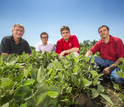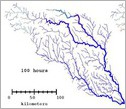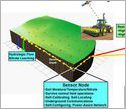News Release 13-203
NSF supports collaborative cyber-enabled research to advance sustainability
CyberSEES program awards $12.5 million for interdisciplinary research in energy, agriculture and environmental management

Oregon State researchers model spatially spreading processes like wildfires caused by lightning.
December 17, 2013
This material is available primarily for archival purposes. Telephone numbers or other contact information may be out of date; please see current contact information at media contacts.
The National Science Foundation (NSF) recently awarded more than $12.5 million in grants to 17 research groups spanning 15 states, each targeting important societal challenges that can be addressed through computing and communication technologies. The two- to four-year grants will allow researchers to plan, prototype, test and build capacity for new models, technologies and tools to increase sustainability.
Advances in computing and information technology are essential to addressing the global challenge of environmental sustainability. Computational and data-enabled techniques, such as simulation and modeling, sensor technology and machine learning, enable researchers to better understand the complexity of the environment and to deliver solutions to achieve sustainability.
"From tiny, low-power sensors able to monitor and transmit information about the movement and quality of rivers to powerful supercomputers that incorporate petabytes of data to model weather, cyber-enabled technologies have the potential to greatly improve our understanding and management of natural and man-made systems," said Farnam Jahanian, head of the Computer and Information Science and Engineering Directorate at NSF.
NSF's Cyber-Enabled Sustainability Science and Engineering (CyberSEES) program aims to realize this potential by advancing interdisciplinary research in which the science and engineering of sustainability are enhanced by new advances in computing. It supports research collaborations that bring together computer, communications and control experts with researchers in agriculture, power infrastructure and transportation to develop innovative ideas and prototype systems to preserve the planet.
The program complements the broader NSF-wide SEES (Science, Engineering and Education for Sustainability) effort, begun in 2012, that funds projects related to hazard mitigation, ocean stewardship and Arctic management, among other topics. All SEES solicitations share a common vision of creating a research and innovation infrastructure that contributes to a sustainable future globally.
The CyberSEES awards range from $300,000 to $1.2 million and support teams of researchers, in some cases across several universities.
"CyberSEES brings together researchers working in computer science, electrical engineering and mechanical engineering with researchers in the geological sciences, biological sciences and emerging areas of sustainability and power systems," said Phillip Regalia, the NSF program officer who oversees the effort. "The CyberSEES program spans many areas because sustainability touches everything on the planet."
Among the recipients of the first CyberSEES awards are groups developing integrated management systems for data centers, electric grids and transportation infrastructure; teams working to improve crop production using underground wireless sensors connected to irrigation systems; researchers developing new ways to optimize and visualize ecosystem management in order to facilitate decision-making; teams using machine learning to better predict precipitation based on multiple sources of information; and even consumer-oriented projects, such as one that diagnoses faults in HVAC systems.
"Our new CyberSEES grant will allow continuing progress towards the goal of cyber-enabled sustainable agriculture through inter-disciplinary research involving sensor electronics, antenna design for underground placement, nano-scale technologies for sensing and energy-harvesting, and computing and networking science," said Ratnesh Kumar, professor of Electrical and Computer Engineering at Iowa State.
Working with electrical engineers and agronomists, he is developing an integrated system to better manage the nitrogen cycle in soils to maximize plant production while minimizing pollution through runoff.
"There is a huge benefit to society in this work, which strives to create more sustainable ways to power our lives," said Diana Marculescu, professor of Electrical and Computer Engineering at Carnegie Mellon University. She leads a team of researchers based at CMU, The University of Texas at Austin and Penn State that aims to develop climate-aware hydropower generation able to maximize the energy harvested from rivers, while avoiding disasters like floods.
According to Marculescu, "Small footprint hydroelectric projects could create enough low-carbon energy to power an economy the size of Virginia while minimizing impact to the environment and surrounding communities."
As computing and communications technologies get cheaper, smaller and more capable, scientists are finding innovative ways of incorporating them into all aspects of life. Through the CyberSEES program, NSF hopes to embed these emerging technologies in ways that will have a positive environmental and social impact.
2013 CyberSEES Awards
Climate-aware renewable hydropower generation and disaster avoidance
Principal Investigators: Diana Marculescu, Carnegie-Mellon University; Seth Blumsack, Penn State; Ben Hodges, The University of Texas at Austin; Paul Bogdan, University of Southern California
Additional Collaborators: Radu Marculescu, CMU
In-situ, wireless, energy-harvesting soil moisture/nutrient sensors for managing agricultural resources & environmental impact
Principal Investigator: Ratnesh Kumar
Additional Collaborators: Fernando Miguez, Michael Castellano, Robert Weber, Liang Dong, Iowa State University
Data integration for urban metabolism
Principal Investigator: Maria Cruz
Additional Collaborators: Ning Ai, Sybil Derrible, Thomas Theis, Samuel Dorevitch, University of Illinois at Chicago
A new framework for crowd-sourced green infrastructure design
Principal Investigators: Lawrence Band, University of North Carolina at Chapel Hill; Barbara Minsker, University of Illinois at Urbana-Champaign
Additional Collaborators: Jack Snoeyink, Mary Whitton, University of North Carolina at Chapel Hill; William Sullivan, Arthur Schmidt, Jong Lee, Kenton McHenry, University of Illinois at Urbana-Champaign
Fault detection, diagnosis and prognosis of HVAC systems
Principal Investigator: Krishna Pattipati, University of Connecticut
Additional Collaborators: Peter Luh, Robert Gao, Bing Wang, George Kuchel, University of Connecticut
Towards sustainable aquatic ecosystems: A new adaptive sampling and data-enabled monitoring and modeling framework
Principal Investigator: Xiaobo Tan, Michigan State University
Additional Collaborators: Elena Litchman, Hayder Radha, Mantha Phanikumar, Guoliang Xing, Michigan State University
Coupon incentive-based risk aware demand response in smart grid
Principal Investigator: Pravin Varaiya, University of California-Berkeley; Le Xie, Texas Engineering Experiment Station
Additional Collaborators: Evdokia Nikolova, Texas Engineering Experiment Station
Enabling sustainable civil infrastructure using interactive formal analytics for structural health diagnosis
Principal Investigator: Ehab Al-Shaer, University of North Carolina at Charlotte
Additional Collaborators: Mary Lou Maher, Matthew Whelan, Xiaoyu Wang, University of North Carolina at Charlotte
Precipitation estimation from multi-source information using advanced machine learning
Principal Investigator: Soroosh Sorooshian, University of California-Irvine
Additional Collaborators: Xiaogang Gao, Kuolin Hsu, Alexander Ihler, University of California-Irvine
Hierarchical energy management for sustainable residential and mobility ecosystems
Principal Investigator: Giorgio Rizzoni, Ohio State UniversityAdditional Collaborators: Wei Zhang, Ohio State University
Computing and visualizing optimal policies for ecosystem management
Principal Investigator: Thomas Dietterich, Oregon State UniversityAdditional Collaborators: Claire Montgomery, Ronald Metoyer, Heidi Albers, Mark Crowley, Oregon State University
Dynamic robust optimization for emerging energy systems
Principal Investigator:Shabbir Ahmed, Georgia Tech
Additional Collaborators: Carlos Grijalva, Xu Sun, Georgia Tech
Integrated management of data centers, electric grid, and transportation for cyber-enabled sustainability
Principal Investigator: Wei Zhang, Ohio State University
Additional Collaborators: Xiaorui Wang, Ohio State University
Improving crop production efficiency using wireless underground sensor-guided irrigation systems
Principal Investigator: Mehmet Vuran, University of Nebraska-Lincoln
Additional Collaborator: Suat Irmak, University of Nebraska-Lincoln
A pilot study on Cognitive Acoustic Underwater Networks (CAUNet) for sustainable ocean monitoring and exploration
Principal Investigator: Zheng Peng, University of Connecticut; Wei Cheng, University of Massachusetts Lowell, Mardi Hastings, Georgia Tech
Additional Collaborators: Suat Irmak, University of Nebraska-Lincoln; Jie Wang, University of Massachusetts Lowell
Framework to Advance Climate, Economics, and Impact Investigations with Information Technology (FACE-IT)
Principal Investigator: Ian Foster, University of Chicago; James Jones, University of Florida
Additional Collaborator: Joshua Elliott, University of Chicago
-NSF-
-
University of Nebraska-Lincoln researchers developed a wireless underground sensor system.
Credit and Larger Version -
Flow and depth modeling during a two-week rainstorm for 15,000 km of rivers in Texas.
Credit and Larger Version -
Proposed soil sensor network to enable precision and sustainable agriculture.
Credit and Larger Version
Media Contacts
Aaron Dubrow, NSF, 703-292-4489, email: adubrow@nsf.gov
Related Websites
Science, Engineering and Education for Sustainability NSF-Wide Investment (SEES): http://www.nsf.gov/sees
Cyber-Enabled Sustainability Science and Engineering (CyberSEES): http://www.nsf.gov/funding/pgm_summ.jsp?pims_id=504829
National Academy of Sciences Publication: Computing Research for Sustainability (2012): http://www.nap.edu/openbook.php?record_id=13415&page=1
The U.S. National Science Foundation propels the nation forward by advancing fundamental research in all fields of science and engineering. NSF supports research and people by providing facilities, instruments and funding to support their ingenuity and sustain the U.S. as a global leader in research and innovation. With a fiscal year 2023 budget of $9.5 billion, NSF funds reach all 50 states through grants to nearly 2,000 colleges, universities and institutions. Each year, NSF receives more than 40,000 competitive proposals and makes about 11,000 new awards. Those awards include support for cooperative research with industry, Arctic and Antarctic research and operations, and U.S. participation in international scientific efforts.
Connect with us online
NSF website: nsf.gov
NSF News: nsf.gov/news
For News Media: nsf.gov/news/newsroom
Statistics: nsf.gov/statistics/
Awards database: nsf.gov/awardsearch/
Follow us on social
Twitter: twitter.com/NSF
Facebook: facebook.com/US.NSF
Instagram: instagram.com/nsfgov



